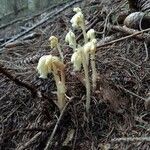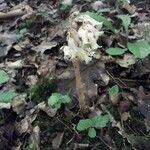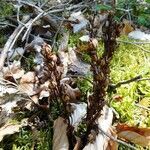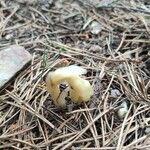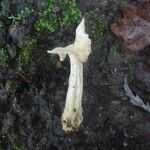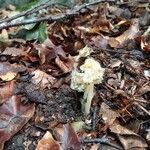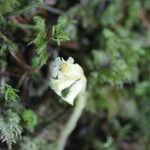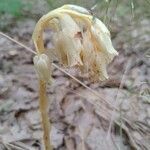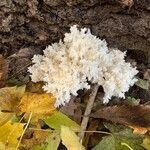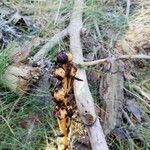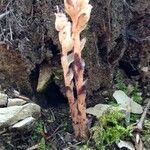Herbs pale yellow-brown, rather fleshy, becoming brown when dry, usually pubescent on upper part of inflorescence. Inflorescence racemose, (1 or)2–11-flowered, 5–30 cm tall, 1–5 mm in diam. below lowermost flower, emerging from soil in nodding position. Inflorescence bracts below soil level shorter and thicker and more densely crowded on axis than upper bracts. Inflorescence bracts above soil level, sessile, ± erect, ovate to oblong, 7–15 × 3–15 mm, rather fleshy, somewhat pubescent to glabrous, margin entire or erose to irregularly toothed, apex acute to acuminate. Flowers nodding, tubular-campanulate. Bracts 1, rarely to 3, similar to inflorescence bracts in size and shape. Sepals 3–5, occasionally absent, oblong to broadly elliptic, 6–10 × 2–5 mm, shorter than petals, base attenuate, margin irregularly toothed, apex acute or acuminate. Petals 4–6, oblong, 1–1.5 cm × 3–6 mm, abaxially finely pubescent, adaxially long pubescent, base saccate, margin entire and irregularly denticulate or erose in upper part, apex acute or rounded. Stamens 8–12; filaments 7–14 mm, pubescent; anthers hippocrepiform, short, 0.8–1.5 mm, opening by a solitary terminal slit over connate sacs. Ovary 4–8 mm, 3–6 mm in diam. at anthesis, placentae axile; style 2–10 mm, ca. as long as ovary, slender, pubescent, articulation between style and ovary conspicuous. Stigma yellow, funnelform, 1.5–3 mm in diam., often subtended by a ring of short hairs, usually pubescent. Nectary at base of ovary with 8–10 paired lobes directed downward between staminal bases opposite saccate bases of petals. Capsules erect, broadly ellipsoid, 6–10 mm, 4–8 mm in diam. Fl. Jul–Aug, fr. Sep–Oct.
More
Inflorescences usually secund racemes, rarely solitary flowers, 5-32 cm; axis yellowish to orange or reddish. Pedicels nodding at anthesis, erect in fruit, (finely hairy or glabrous, sometimes glandular-hairy. Flowers: sepals absent or 4-5, not similar to subtending bracts, spatulate to elliptic, 7-12 × 1-5 mm; petals 4-5, yellowish to orange or reddish, oblong, 8-17 × 4-8 mm, base narrowly saccate, margins ciliate to erose, apex acute to rounded, adaxial surfaces often hairy; nectary lobes 8-10, (paired), stout, not elongate or curved-cylindric; stamens 8-10; filaments sparsely hairy; anthers horizontal at anthesis, horseshoe-shaped, sacs of equal size; ovary 4-8 × 3-6 mm, usually hairy; style 2-10 × 1-2 mm, sparsely hairy; stigma umbilicate, 1.5-3 mm diam., often subtended by ring of crowded hairs. Capsules 4-5-segmented; segments often deciduous after seed dispersal, thin, 6-10 × 4-8 mm, without connecting, pinnate, vascular bundles when open. Seeds 0.5-1 mm, mostly membranously winged. 2n = 48.
Stems 1–3 dm, often clustered, yellow, tawny, pink, or red, ± pubescent; raceme dense, at first nodding, erect at anthesis; fls 8–18 mm, the lower usually 4-merous, the terminal often larger and 5-merous; sep lanceolate, erect, unlike the basally saccate pet; anthers opening by a single cleft into 2 very unequal valves; style shorter than the ovary; stigma ± villous at the margin; 2n=16, 48. Moist or dry woods, usually in acid soil; interruptedly circumboreal, but not at high latitudes, in Amer. s. to Fla. and Mex. (Hypopitys americana)
